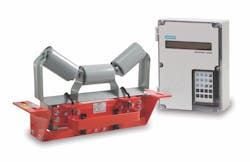Weighing: A Practical IIoT Application
It’s easy to become overwhelmed by all the digital technologies and data handling processes involved with the Industrial Internet of Things (IIoT)—from transmitting data to the cloud to determining data analysis parameters to building the apps to access the data. As difficult as it all may sound, technology suppliers have been increasingly focused on simplifying these processes to enable companies of all sizes to benefit from the technology.
Matt Morrissey, product manager at Siemens, suggests weighing operations as a great place to start with IIoT because it’s a good way to better understand the technology and its possibilities, and reap significant savings through problem identification and process improvement.
Weighing is a straightforward IIoT application because the weight of materials used in production processes is monitored using load cells— basic mechanical sensors that deflect under changes in mass and produce an electrical signal proportionate to the change in deflection. A controller or integrator collects this electrical signal and converts it into a process variable, which can be used by the control system to monitor or manage the process.
“If we want to analyze this data and compare it to environmental conditions or other process variables such as level or pressure,” Morrissey says, “we might then be able to correlate the data to look for opportunities to refine our process or gain an efficiency along the way.”
To provide a real world example of how this can work, Morrissey points to belt scales, which are used in multiple industries to weigh material while it is being conveyed from one point to another. Morrissey likes to use belt scales as an example for complex, yet approachable IIoT data analyses because there are so many factors that can affect a belt scale’s accuracy. For example, temperature effects on the belt tension or density of the material due to moisture content, to name just a couple.
To illustrate his example scenario, Morrissey says to imagine you have three conveyors equipped with belt scales, each moving one ton of raw material per hour into the plant. “That means three tons of raw material per hour going in,” he said. “At the other end of the line you have finished goods leaving your plant comprised of just two and a half tons per hour of material. If three tons are going in, shouldn’t you have three tons coming out? Where did that other half ton per hour disappear to?”
Morrissey notes that this scenario is a common production problem for many manufacturers. It’s easy enough to regularly monitor the belt scale’s readings, he says, but solving accuracy issues external to the belt scale is not so simple.
“Of course, you could take the belt scale readings and export them into a spreadsheet, go online and look at the weather trends for temperature and rain over the last month, chart that data along with your belt scale readings, and then manually chart the data to look for trends or impacts when temperature or rain goes up or down,” Morrissey says. “But this sort of data mining and analysis can take hours, depending on the level of detail—and getting some of this data may not be possible based on the data logging that is available.”
To explain how this kind of analysis is easily handled with an IIoT approach, Morrissey says to first consider that your belt scale is connected to an integrator which is connected to a programmable logic controller (PLC). The PLC controls and monitors the entire plant.
The PLC takes the belt’s data points—along with inputs from other production-related devices—and assigns them to data blocks. “So far, this is a pretty standard setup in process industries,” he says. “But now you can take that information in the PLC and connect it to the cloud.”
Siemens offers the MindConnect IoT2040 and MindConnect Nano to handle this kind of PLC data transmission to the cloud. Morrissey points out that both of these products feature integral security so that information cannot be accessed from the web without proper validation and encryption.
“For our belt scale example application, let’s use the MindConnect IoT2040 as our gateway solution and connect our PLC to it via Ethernet,” he says. “Now we have a way to get our data onto the Internet—and from there we can collect and monitor that data in Mindsphere (Siemens' cloud-based platform for collecting and analyzing data).
With the data in the cloud, the next step is to create an app. “Similar to the apps you use every day on your phone or tablet to perform specific functions or activities, an app in Mindsphere can be created to collect, trend or chart data and provide a visual representation of it to easily identify issues or opportunities,” Morrissey says. “Our app in this example will take our belt scale outputs of flow, load, speed and total and compare them to the total output of our finished process.”
Using this data, Morrissey says it’s now possible to easily see if there is a relation between the moisture content of the raw material or change in temperature vs. the accuracy of our belt scale on the input of the process vs. the output. By reviewing these parameters, it’ll be possible to account for the missing half ton of material.
“With Mindsphere, you now have a toolset that can compare incoming vs. outgoing material and integrate factors external to your equipment (rainfall, temperature, etc.)—in an effort to shed some light on your process’ accuracy and overall efficiency,” Morrissey says. “All this can be displayed directly from sensors and viewed in Mindsphere online. And since this data is now in the cloud, it is accessible anywhere in the world—so your global infrastructure is now with you wherever you are and whenever you need it.”

